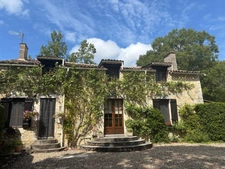
Many Dordogne towns are situated on the banks of the River. It’s in an area known as Périgord Pourpre (purple Périgord). A land of lush vineyards, the Purple Périgord is also famous for its rolling hills and fields of sunflowers peppered with tiny hamlets and grand castles. Medieval Bergerac sits in the heart of the region. A gourmet paradise, perfect for history buffs, wine lovers and water babies with river rides and canoeing. It’s an ideal base to explore the picturesque countryside and villages of the Dordogne.
The Dordogne and Lot et Garonne are some of the most exciting destinations in France for expats. Britons, Americans, Australians, Dutch, Belgians and many other nationalities love the Dordogne and its environs, which has the second-biggest British expat community after Paris.
The Dordogne has everything you need for a rewarding retirement – from entertainment to excellent living conditions. Many expats create a fantastic new life here, with bold new experiences such as renovating a farmhouse, learning French, starting a local business, or enjoying the social benefits of living in welcoming towns and villages.
The region has much to offer anyone looking for an idyllic French lifestyle. It has some of France’s most beautiful rolling countryside – perfect for walking or driving – and many places to explore and enjoy.The Dordogne Valley is home to a wonderful mix of picture-perfect villages, medieval castles, mysterious caves, gorgeous food, and the calm, beautiful waters of the Dordogne River. Food lovers will be in heaven with the region’s culinary pleasures.
The region also has a rich historical heritage. Its well-kept medieval castles (chateaus in French), prehistoric cave complexes (Lascaux, for example), and more recent historic sites like the Cabanes du Breuil are among its highlights.
Of course, French is the main language, but the area is popular with Expats, meaning English is fairly widely spoken. It’s well worth learning some French, and language classes are quite common in expat circles.
Climate and weather
The Dordogne region enjoys a typical temperate French climate with hot summers and cool winters, but variations can be experienced depending on the area and the time of year.
Summer: In July and August, temperatures often reach their peak, maxing out around40°C (104°F)during the hottest days. These months are typically dry and sunny, perfect for enjoying Dordogne’s outdoor lifestyle, from river activities to exploring the region’s historical sites. Heatwaves can occasionally push temperatures even higher, but the mornings and evenings often bring relief with cooler breezes, especially in rural and forested areas.
Winter: Winters in the Dordogne are cool but not harsh, with temperatures often dropping tofreezing or just below. The average winter day sees highs of around8°C to 10°C (46°F to 50°F), and while snow is rare, frost is common during the coldest months (December to February). Rural areas, particularly near the rivers and valleys, tend to experience colder, mistier mornings.
Microclimates in the Dordogne
While the overall climate is mild, there are some variations in microclimates across the region due to its diverse geography.
Opportunities to seize
My news feed
View all articles
How to invest in REITs (SCPI) in real estate?
Investing in REITs (Sociétés Civiles de Placement Immobilier – SCPI) in real estate remains an attractive solution to build up a rental portfolio with...

Can You Suspend a Mortgage Loan for a Real Estate Sale in France?
Selling a property while still repaying a mortgage often raises the question: can you suspend your mortgage to facilitate the sale or the next purchas...

What is Real Estate Leasing in France?
Real estate leasing is an alternative pathway to homeownership. It combines renting with a purchase option and is growing in popularity due to the inc...

How to Set Up a Real Estate Investment Company (SCI) for a Property Purchase in France
A Société Civile Immobilière (SCI), or Real Estate Investment Company, is a popular legal structure for purchasing property jointly—whether it's a fam...
The main reasons you should be in Dordogne
Beyond its quality of life, temperate climate, and historical heritage,the department of Dordogne proves to be an excellent place to invest due...







